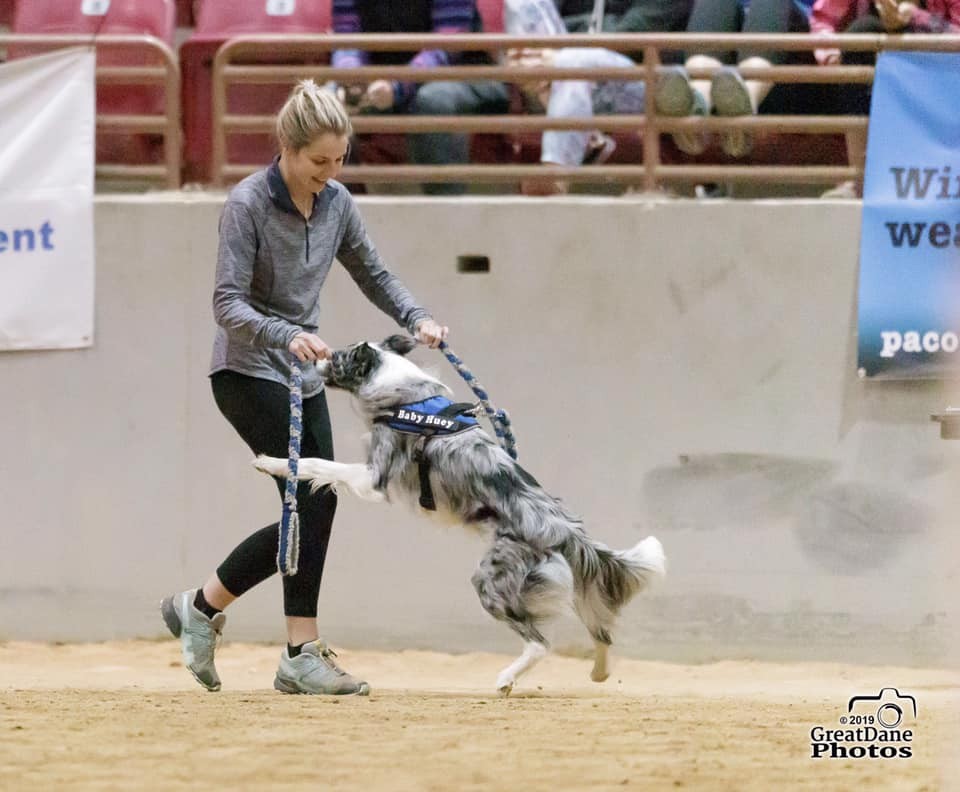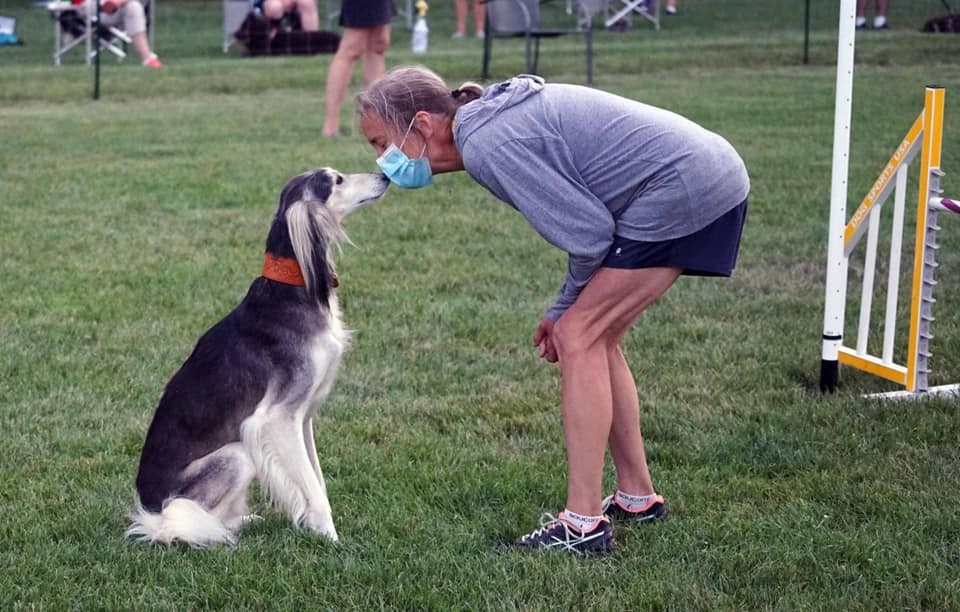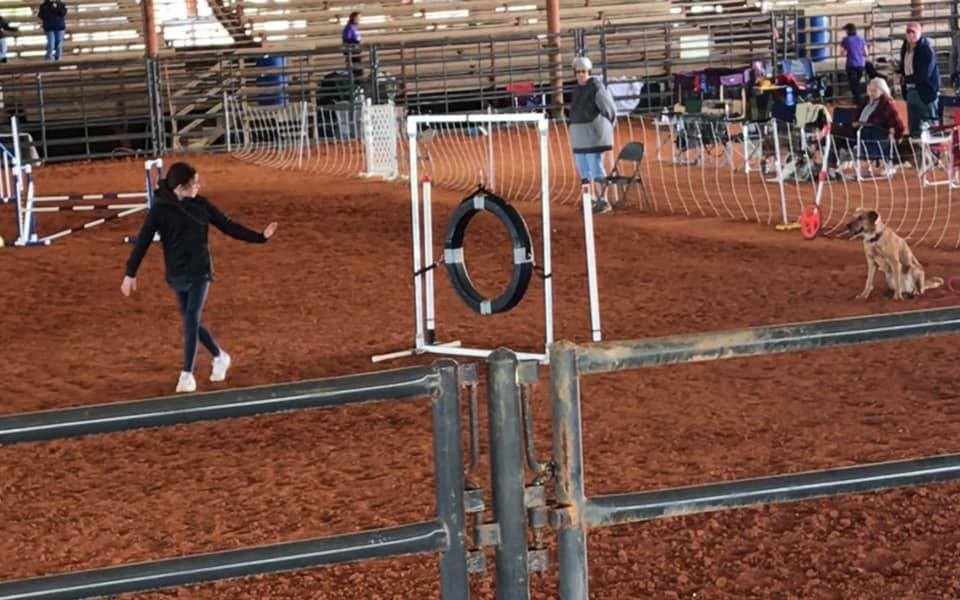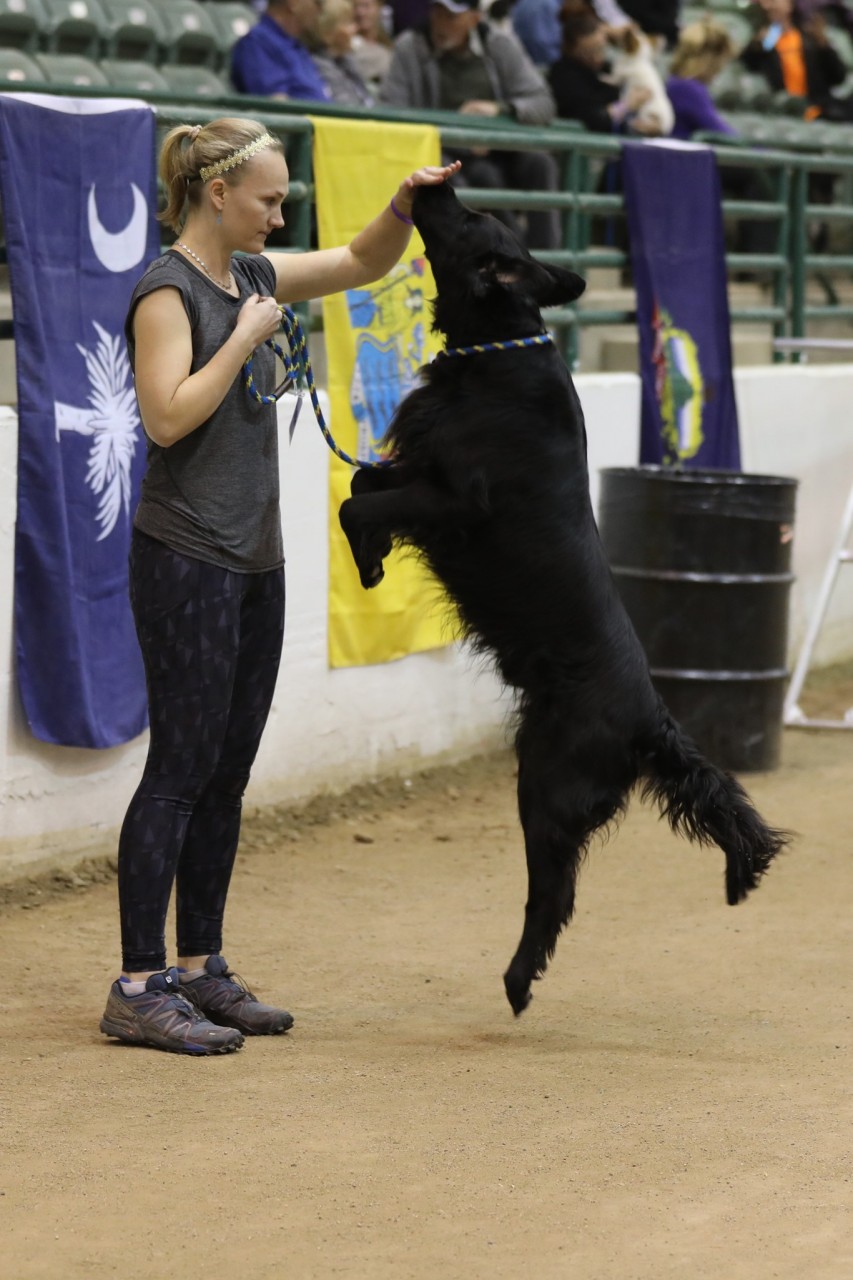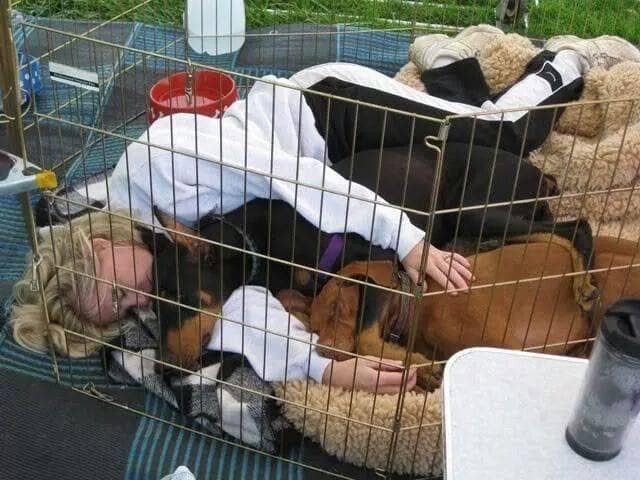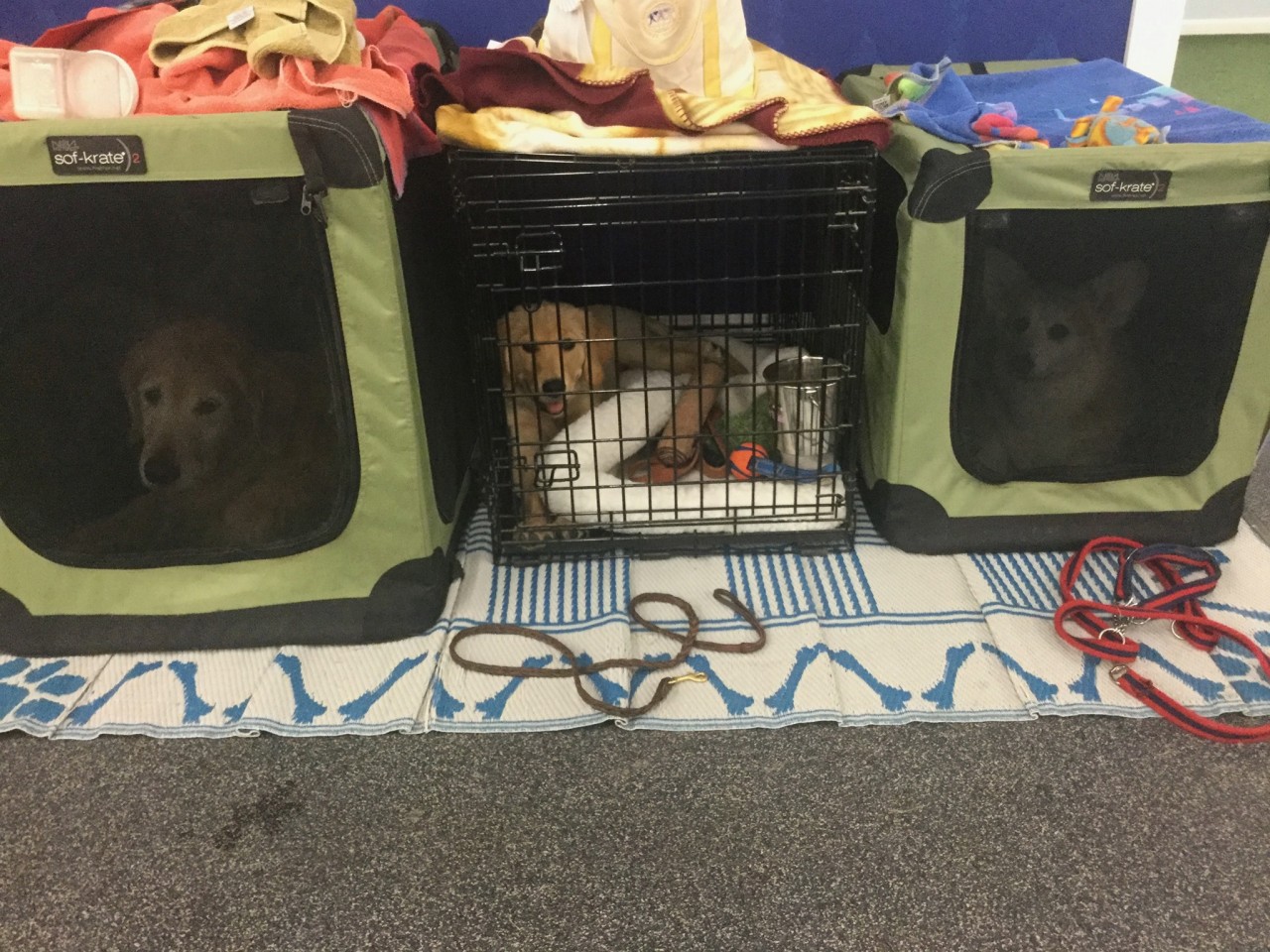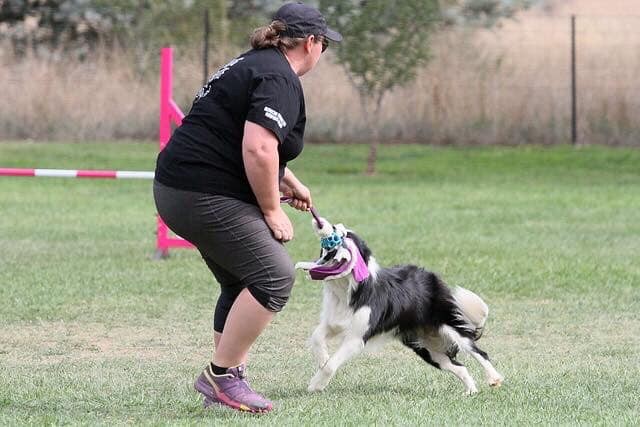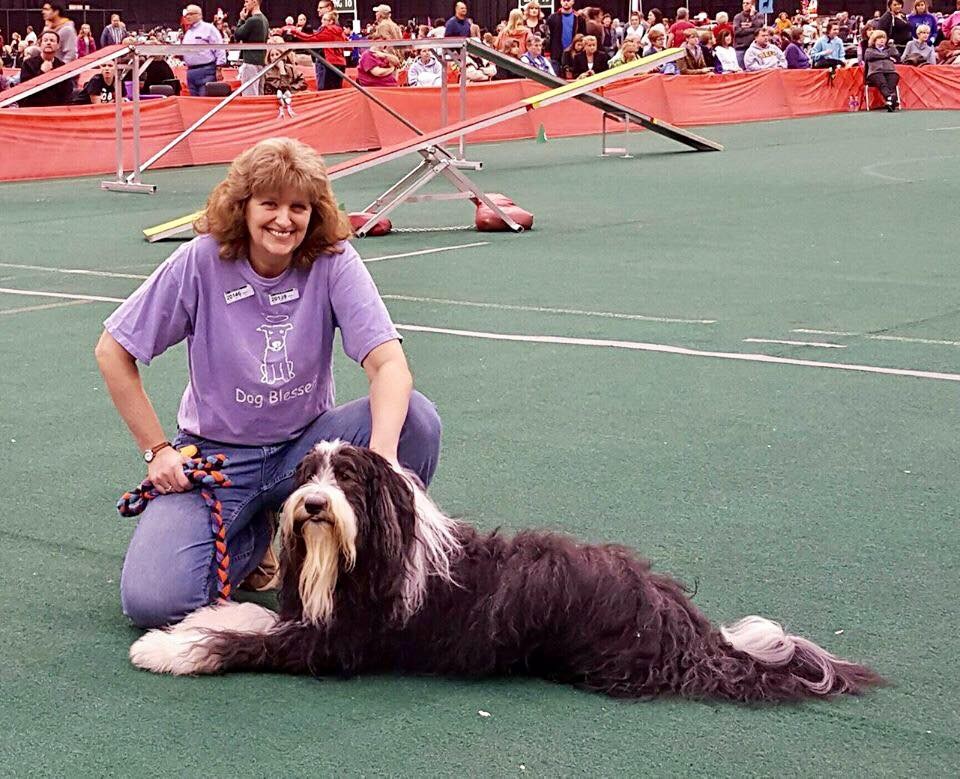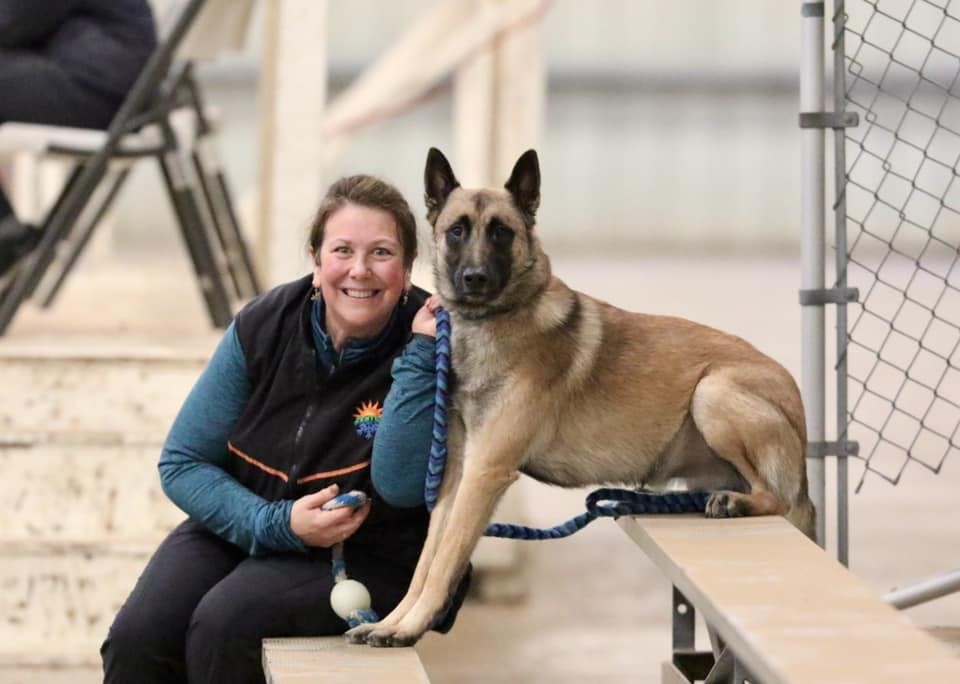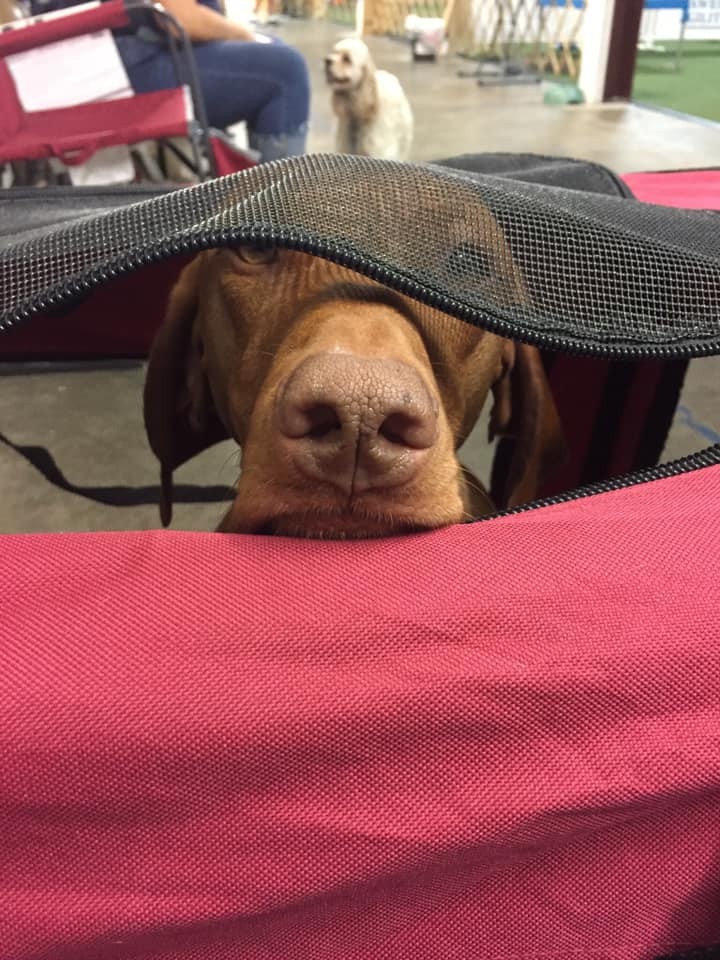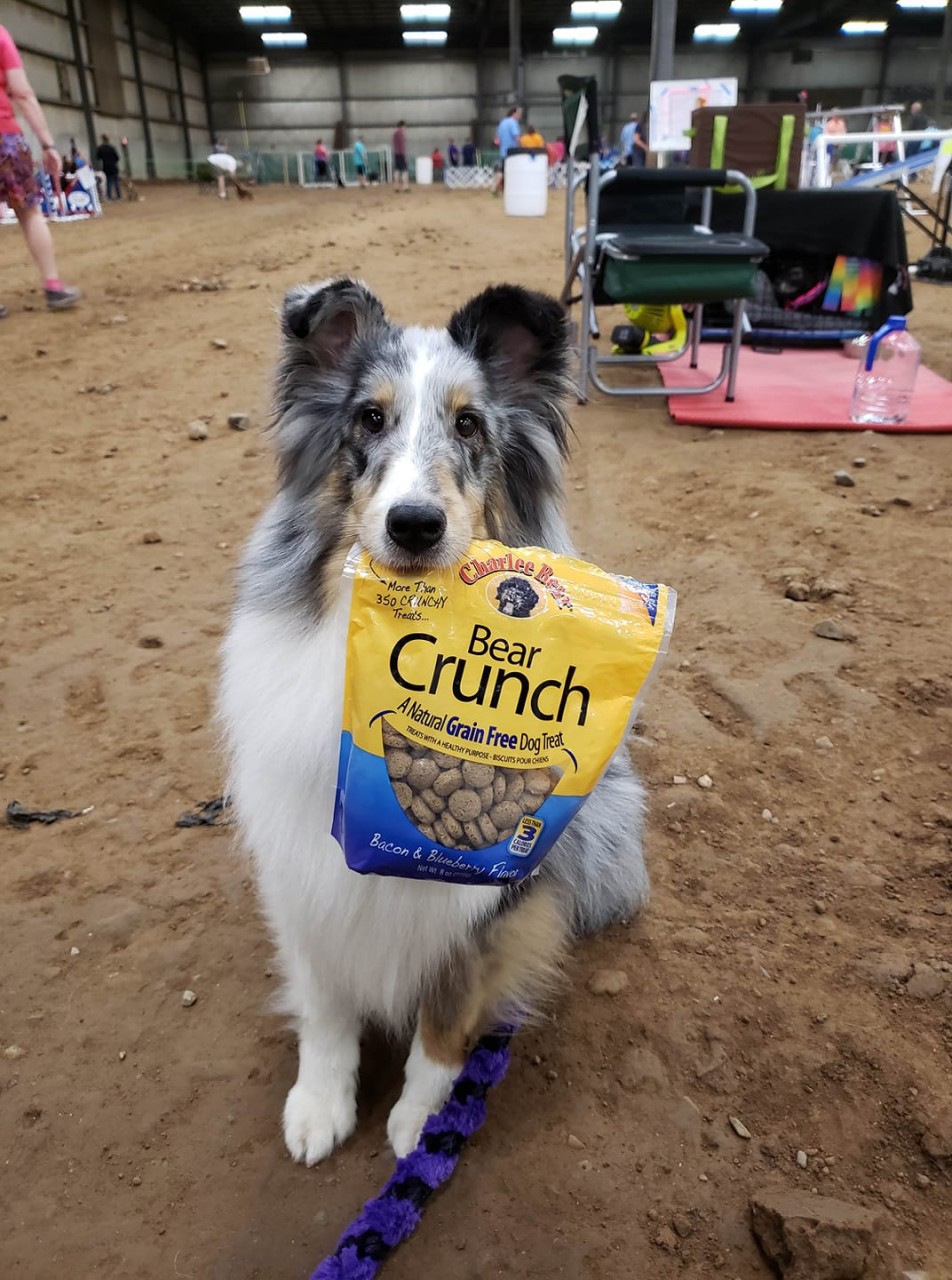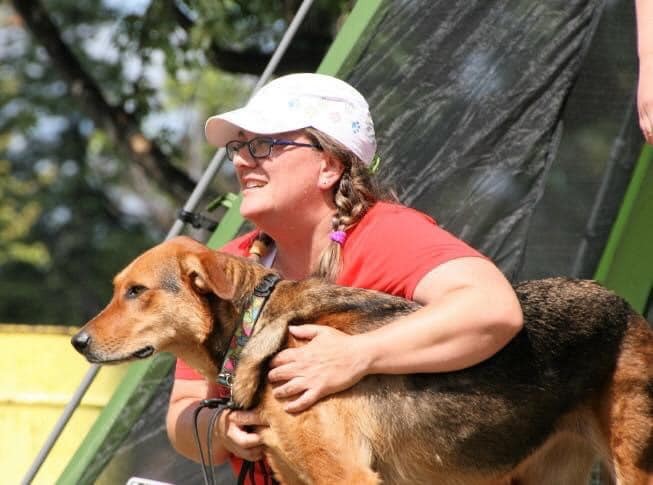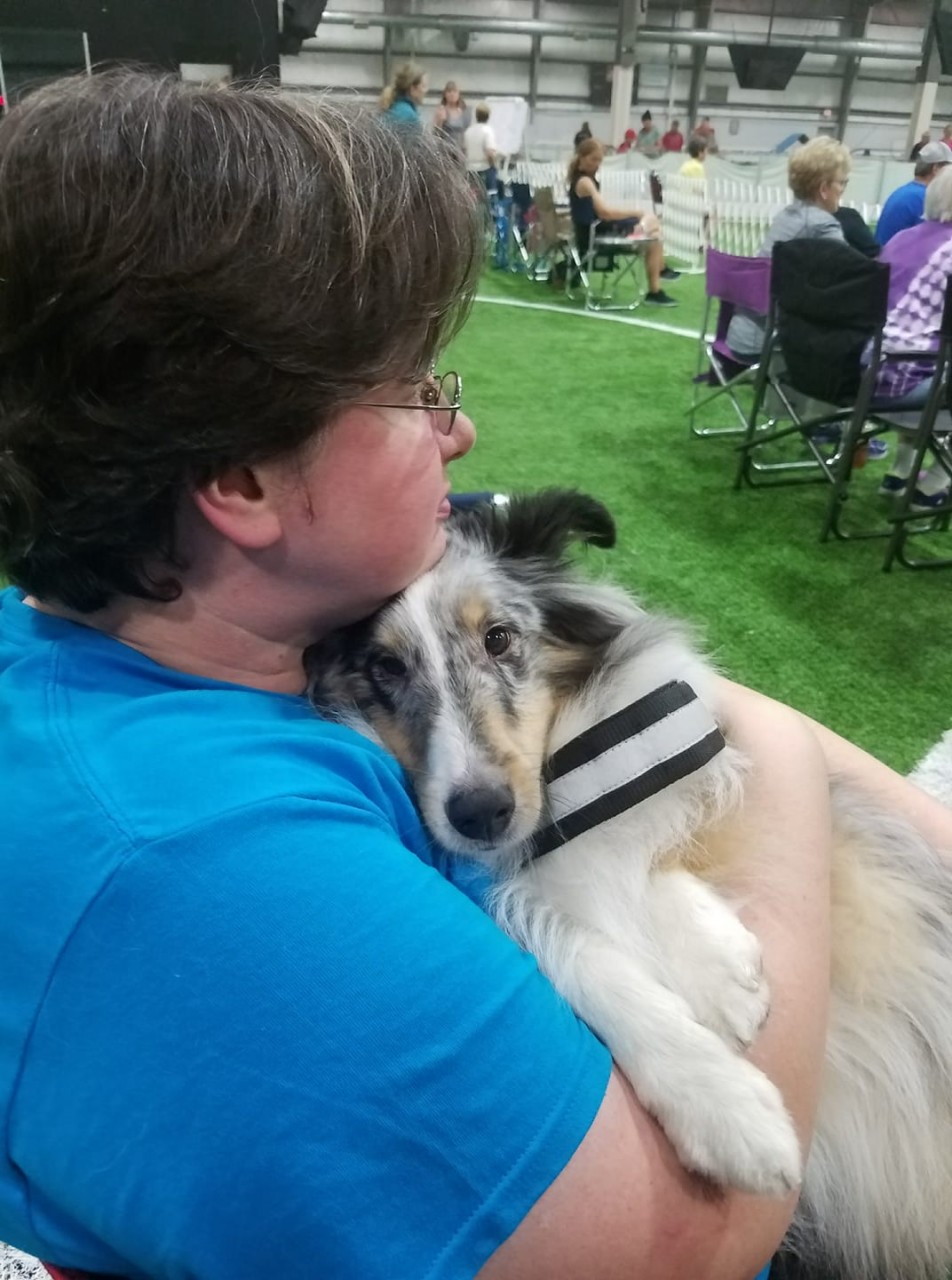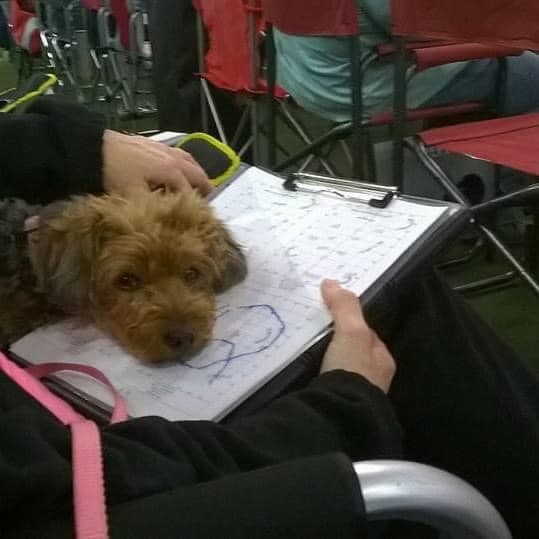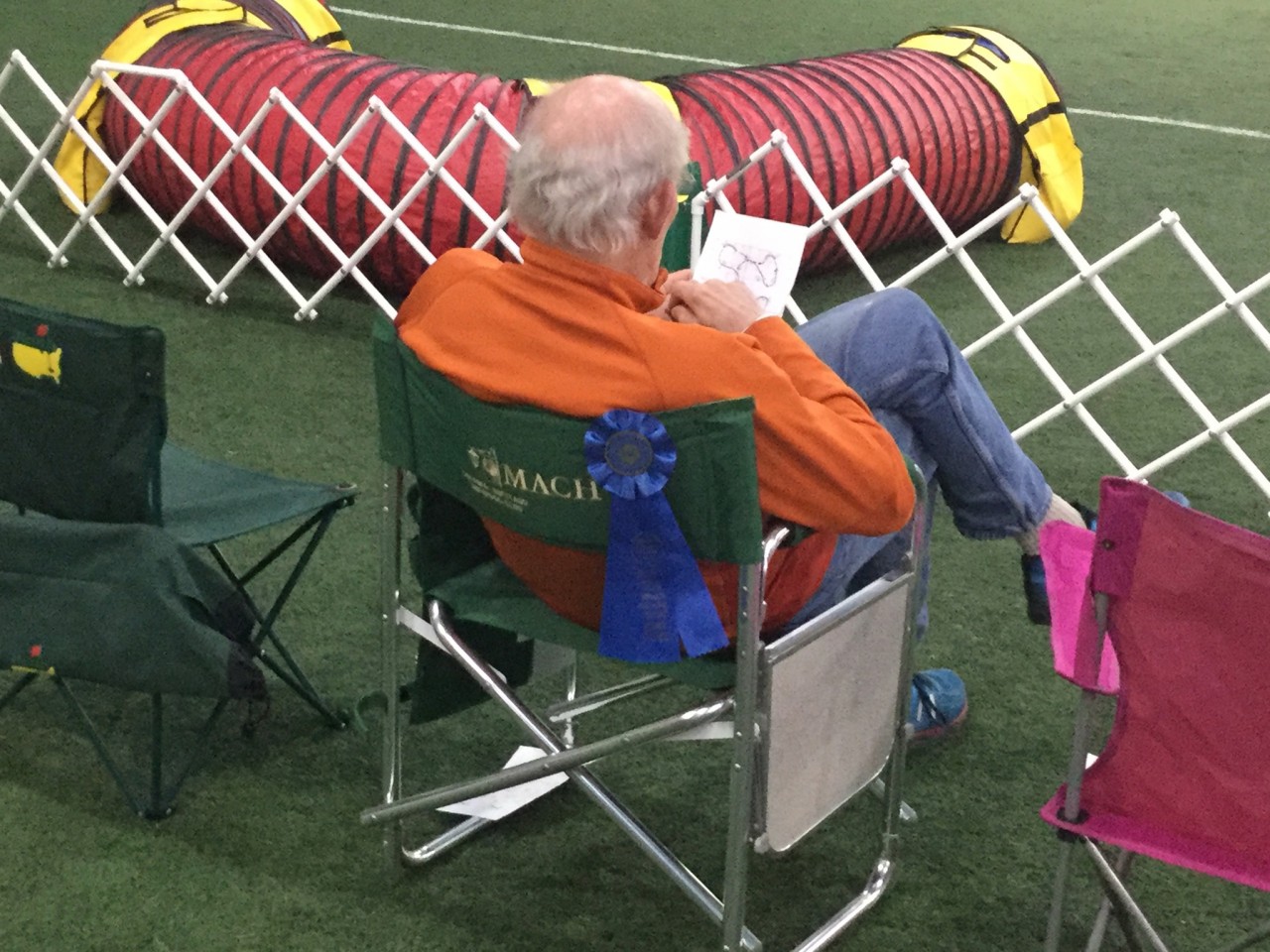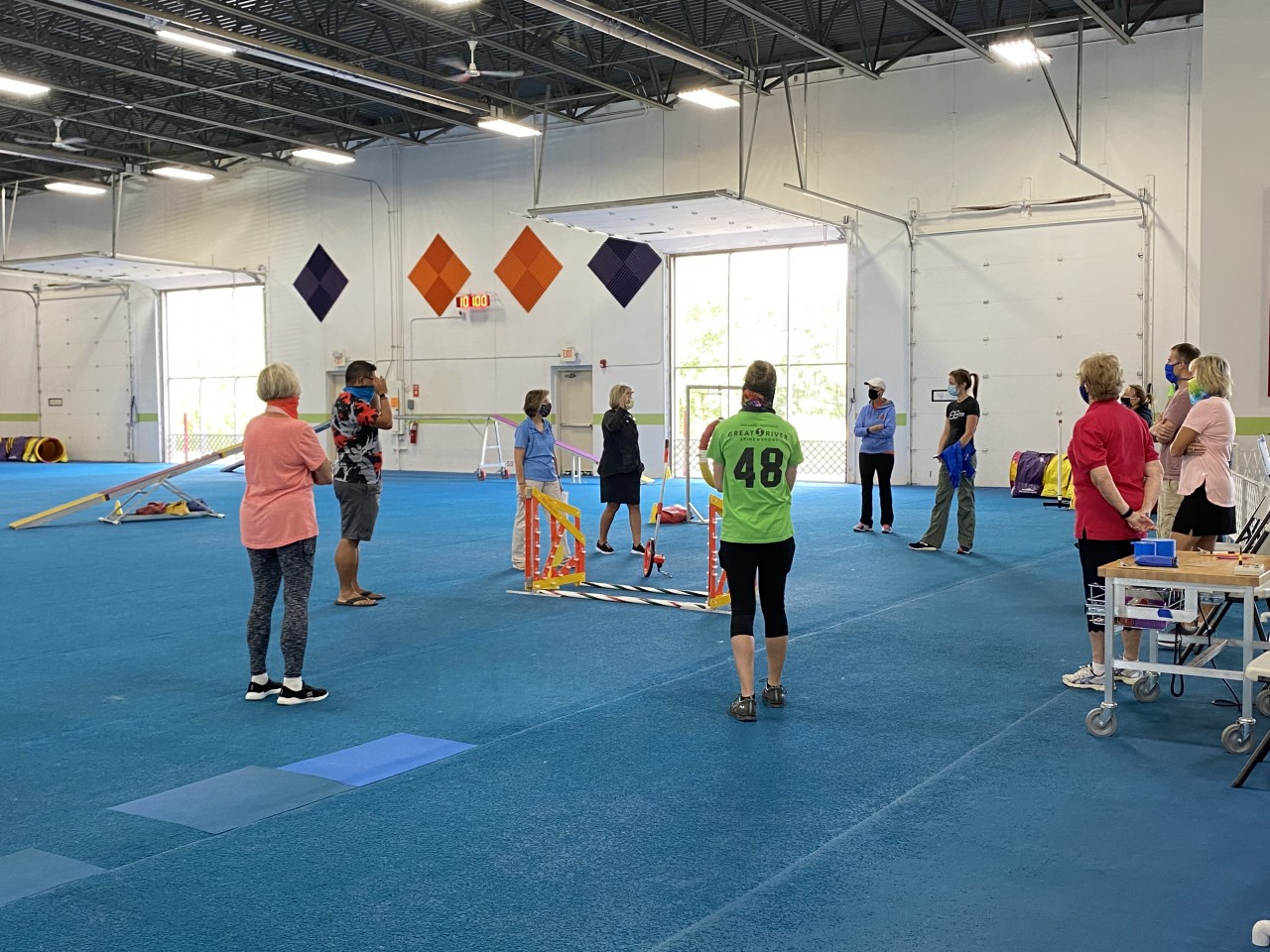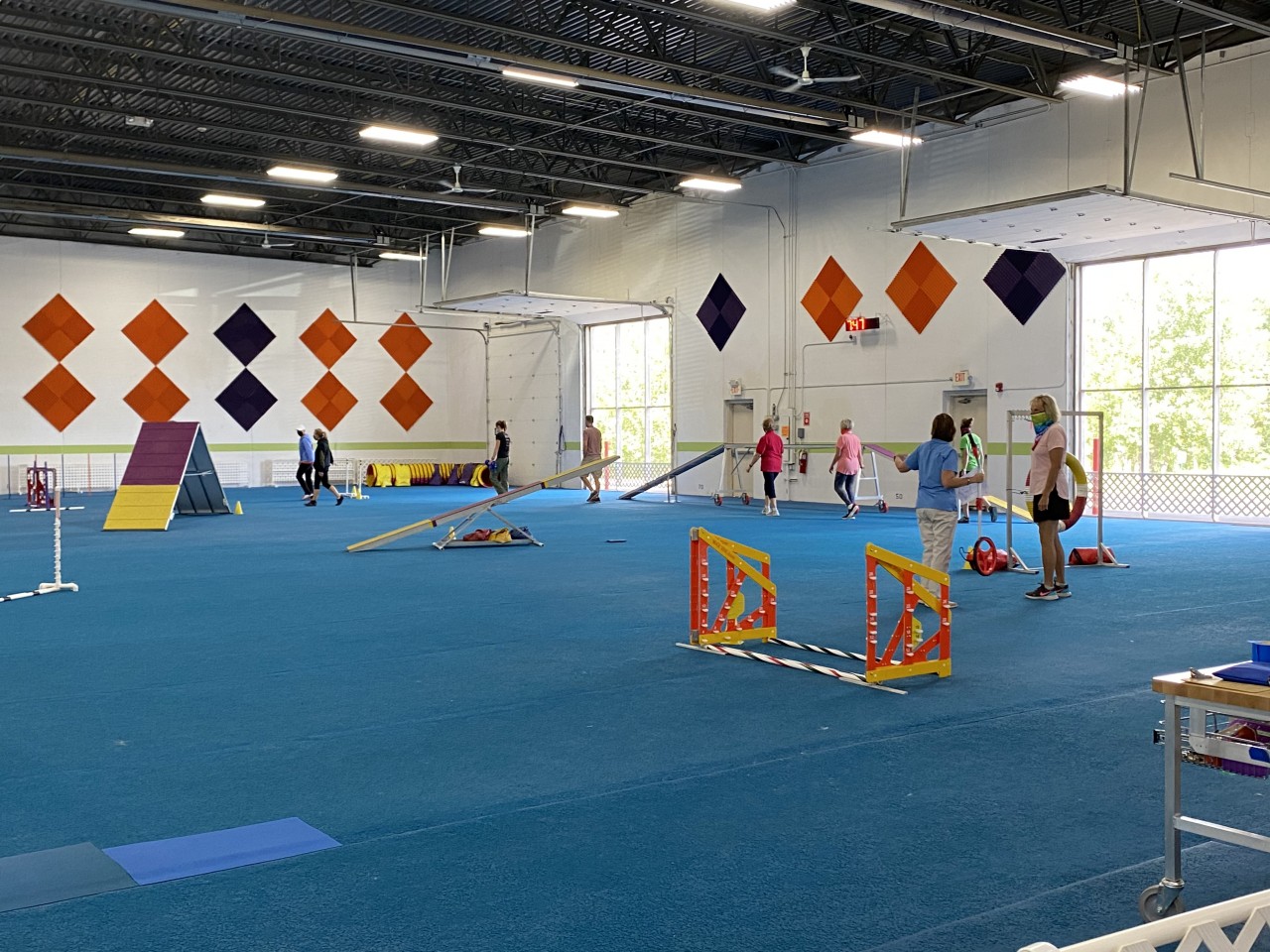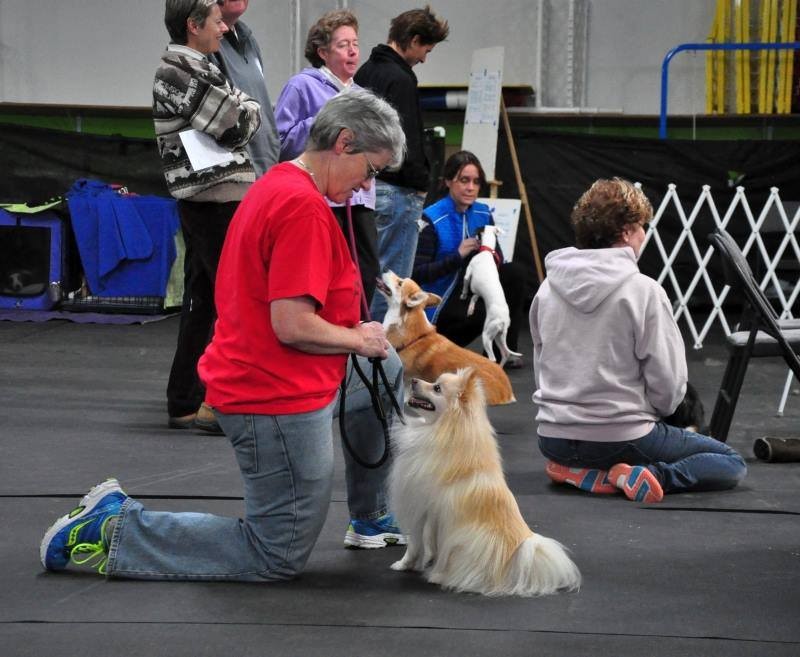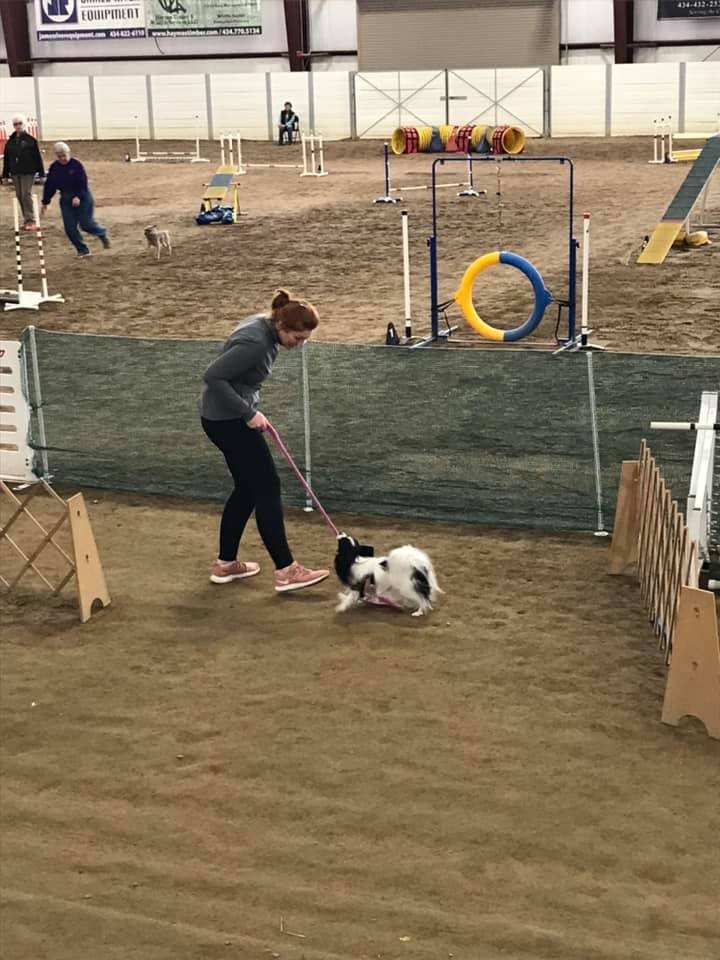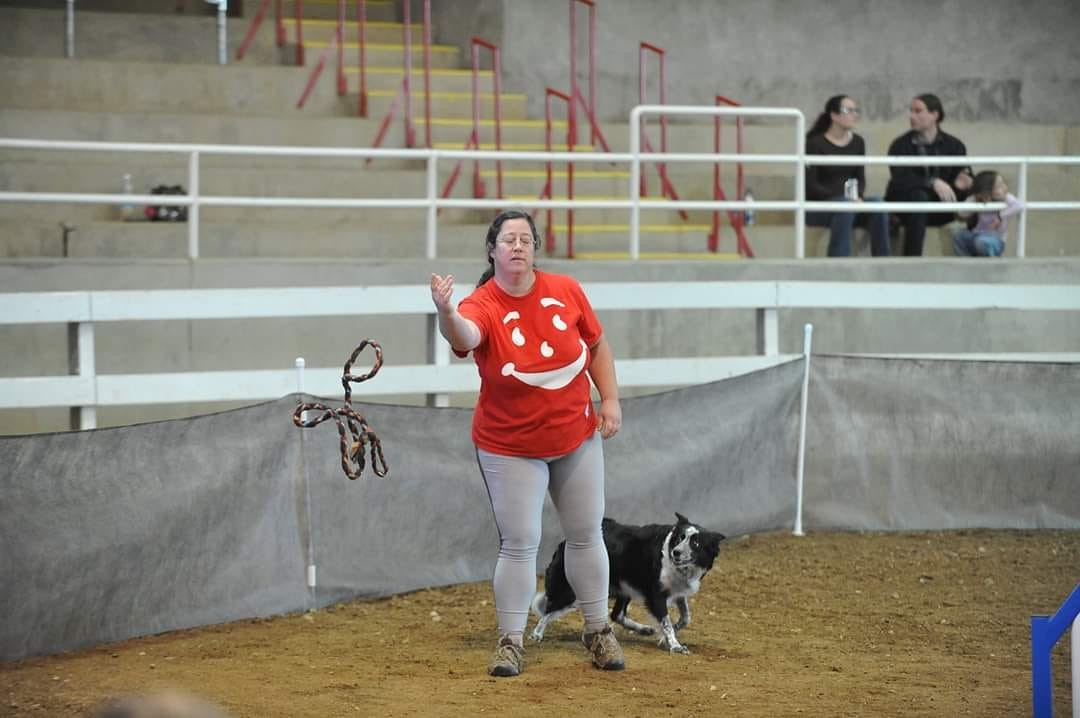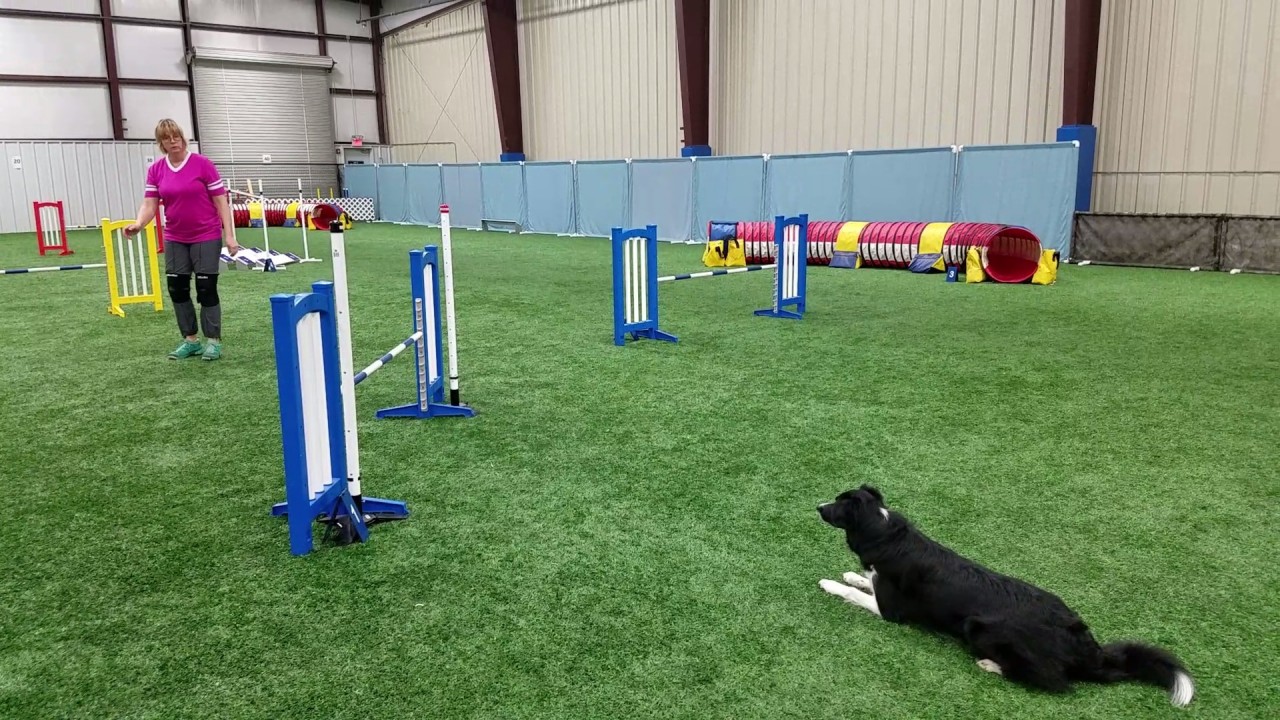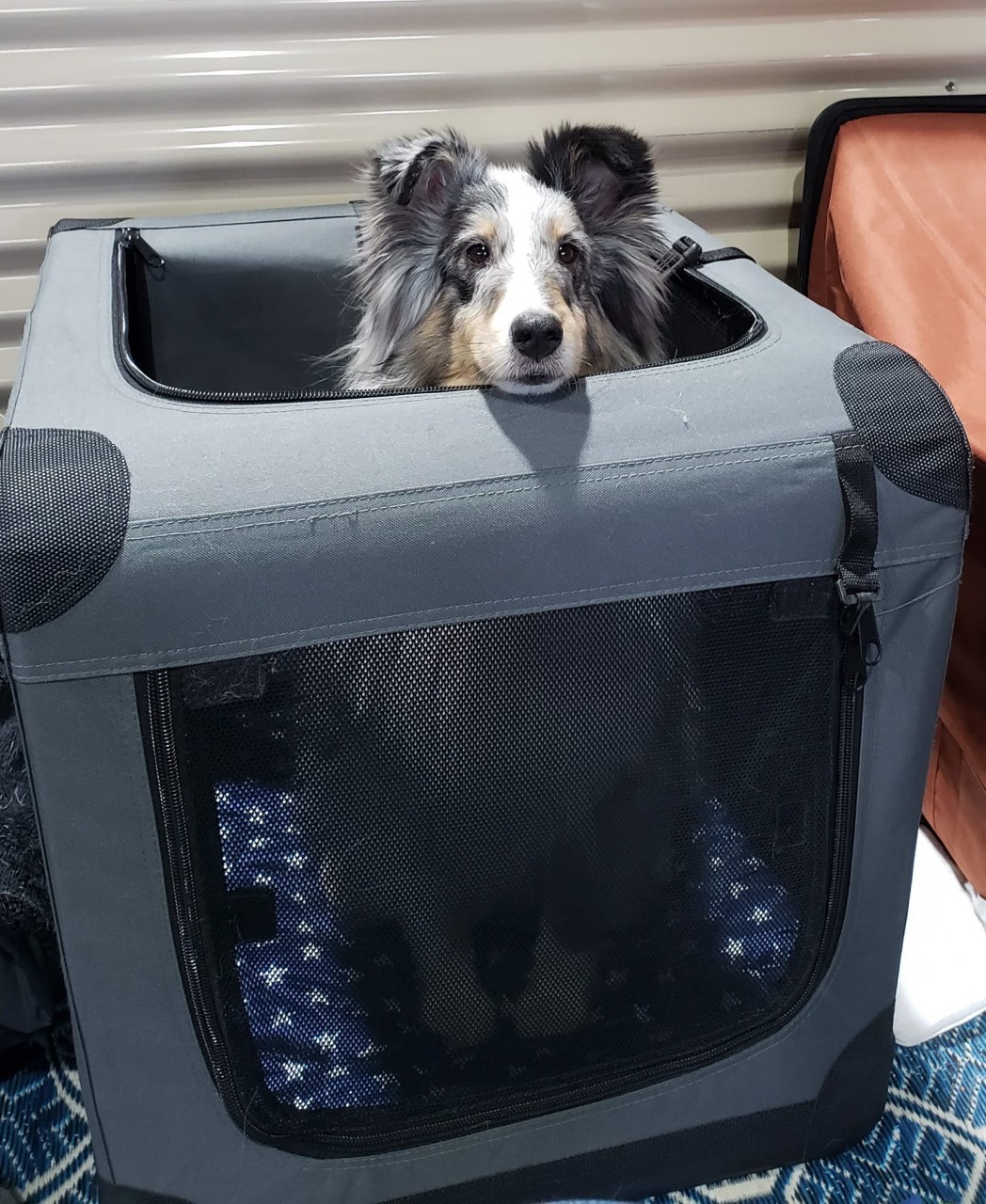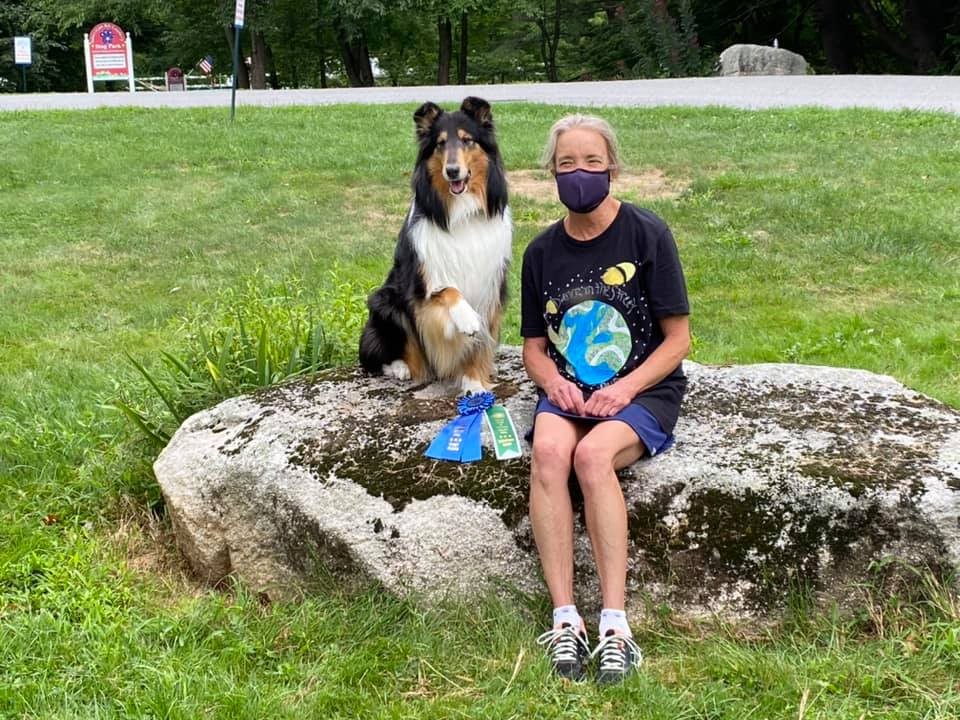Are you thinking about entering an agility trial as a new exhibitor and not sure what to expect? This post will help you:
- Find agility trials,
- Understand what needs to be addressed to prepare for competing,
- Learn the procedure for entering,
- Explain the procedure after you enter,
- Understand what a typical competition day looks like,
- Learn how COVID-19 has affected the trials.
This post focuses on AKC agility. But there are also many other organizations you can check out if they are in your area. Each organization has different classes, strategies, goals, and ways of doing things. There is something for everyone out there!
Pandemic Effect
Keep in mind that the pandemic has forced clubs to implement changes in procedures and routines at the trials. The clubs have recently started to hold trials, and they are learning and continuing to make changes as they go. There will be more changes as time goes on. Some of these changes will be permanent, and some will be temporary. Agility is a very social dog sport, making it challenging to incorporate social distancing. The clubs are figuring out the best ways to do this. But, implementing these procedures causes the trials to look vastly different than they did before the pandemic.
How to find Agility Trials
If you and your dog attend a class or take lessons from an instructor locally, you can ask the instructor or students in the class about their favorite agility trials in your area.
You can find these trials online by visiting the organization's website or the Trial Secretary's website. Your area of the country might have one or more Trial Secretaries hired for your local agility trials.
American Kennel Club website
You can also find AKC agility trials by using the AKC event search tool:
https://webapps.akc.org/event-search//
In the left pane, select the type of event. Agility is listed under Companion Events.
- Click on "Companion Events"
- Select "Agility" in the drop-down menu
In the Location pane on the right, you can limit your search by selecting whether you want an "Indoor," "Outdoor," or "Outdoor with Cover" location. The default selection is all of them.
You can search by state or nearest a city - the default is by state. If you search by state, select the ones you want to be included in that search by clicking on each of them on the United States map.
You can change the start and end dates for the timeframe you want. Then click on "Retrieve Events" at the bottom of the page, which will bring up another page listing all the events from your filtered search.
There are separate event listings for each day of the trial. If you click on the > arrow next to the date, it will list more information, including Trial Secretary and Trial Chair information.
The Trial Secretary handles entries and scoring and can send you a trial premium list that includes the complete information about that trial.
If you click on "View Complete Event Details" at the bottom of the event, another tab will open on your browser with more details. That includes the judging assignments, classes that day, the club's website, email address of the Trial Secretary, the trial location, dates (opening, closing, date of event), and entry fees.
LabTestedOnline.com
LabTestedOnline.com is an online subscription service that lists all the AKC agility trials. This service allows you to print entry forms (filled in with the information you provide for each dog and selected classes for the trial). The entry can be printed and mailed to the Trial Secretary, or you can also enter online with a small fee if the Trial Secretary also uses their services.
There is information, including email addresses of the Trial Secretary, the website, and the premium list. You can find the same information that is listed on the AKC event search.
The regular subscription fee is $10 per year for access. But for new subscribers, there is a 6-month free subscription to this service. Take advantage of this free trial.
Here is the link: https://www.labtestedonline.com/newmember
Other Agility Organizations in the United States and Canada
There are other agility organizations besides the AKC. Below is a list of the most popular agility organizations in the US and Canada. You can find events and the rules and regulations on these websites.
USA:
- Australian Shepherd Club of America (ASCA): https://www.asca.org/agility/
- Companion Performance Events (CPE): http://k9cpe.com/
- North America Dog Agility Council (NADAC): https://www.nadac.com/
- Teacup Dogs Agility Association (TDAA): https://www.k9tdaa.com/
- UK Agility International (UKI): https://ukagilityinternational.com/
- United Kennel Club (UKC): https://www.ukcdogs.com/agility
- United States Dog Agility Association (USDAA): https://www.usdaa.com/
Canada:
- Agility Association of Canada (AAC): https://www.aac.ca/
- Canadian Kennel Club (CKC): https://www.ckc.ca/en/Events/Overview-of-Events/Agility
How To Prepare for an Agility Trial
You have decided that you want to show your dog in agility trials. Excellent!! But you aren't sure what you should do to prepare you and your dog for the competition. What should you do before you enter?
It's beneficial for both you and your dog to be working with an experienced agility instructor – either doing private lessons or classes. The classes will prepare you and your dog for the high energy activity involved at the trials. If your dog has trouble focusing in classes, look into private lessons first while you and your dog learn agility. Then when your dog has more experience with the obstacles and the handling, the classes will be more beneficial.
Your dog must be at least 15 months of age on the day of the trial you want to enter and must be registered with AKC. If you have AKC papers on your dog, your dog is probably already registered. If you do not have AKC registration papers, but your dog is an AKC purebred breed, you can still register with AKC by using their Purebred Alternative Listing (PAL) program:
https://www.akc.org/register/information/purebred-alternative-listing-pal/
If you have a mixed breed or a purebred dog from a breed that is not registrable with AKC, you can register the dog by using their AKC Canine Partners program. You can read more about that program and register your dog by going here: https://www.akc.org/register/information/canine-partners/.
Your dog will have to be measured by a judge to determine the official jump height. You will need to teach your dog how to be measured by a stranger. There must be at least one measurement before you can run officially run your dog in the entered classes. The measurement can occur at a trial previous to the day you entered or before your class starts on the first day. Talk to your instructor to help you understand what's required for that procedure and develop a plan to help your dog. It's a simple procedure, but the measuring device can be a little concerning for some dogs. It pays to prepare your dog ahead of time.
One of the best ways to learn agility is to find out when and where the agility trials are located and volunteer to help. You do not have to know anything about agility trials to volunteer, and you don't have to be entered. There are many jobs – many of them require no previous experience and can help you learn a lot about what goes on in this exciting sport.
If you volunteer to work at a trial you are not entered in, check the premium list to see if there is a Volunteer Measuring Official (VMO) measuring dogs. Your dog must be measured before running in any trial, and you can get that measurement early if you are at another trial. If your dog is two years of age, you will need two measurements from two different VMOs to get a permanent height card (not all judges are VMOs). If your dog is under two years old, then you will get a temporary height form. You won't need another measurement until your dog turns two. Be aware that you cannot get your dog measured unless it is at a trial.
When you run your dog in an agility trial, you can not take food or toys into the ring. It's good to practice this before you surprise your dog at a trial. Dogs can get very confused if the first time they run a sequence without rewards is at a trial. Ensure your dog is familiar with that approach, so they understand that they will still have access to rewards after you run.
Make sure that your dog is familiar with all the obstacles in the classes you plan on entering. Each organization has different obstacle specifications, so check those out in the rules and regulations. In AKC Novice classes (Jumpers with Weaves and Standard), your dog must be able to execute winged and wingless jumps (bars can be between 4 and 5 feet), six weave poles, tunnels, double bar jump, panel jump, tire jump, broad/long jump, triple bar jump, dog walk, a-frame, seesaw/teeter, and the pause table.
Agility trials can have long days, depending on the schedule. Some schedules have the Novice and Open classes at the end of the day after both Master classes. Or they can be held at the beginning of the day before both Master classes. Other schedules have all the Standard classes and all the JWW classes grouped. Example: Master JWW, Open JWW, Novice JWW, Master Standard, Open Standard, Novice Standard. The Master classes are large and can take hours to complete. Your dog should feel comfortable hanging out in a crate – either in the vehicle or in the crating area at the trial. If your dog isn't used to being in a crate for long periods, prepare for this. Your dog will be mentally tired if you don't allow for rest between the runs.
You can enter other classes besides Novice Standard and JWW. One of the classes is called Time 2 Beat (T2B). This class is fast and flowing. There are 12 weave poles, two contacts, and jumps required in this class. Up to two tunnels are allowed, but not required. The contacts can be the teeter and the a-frame. The dog walk is not allowed. Sometimes there is only one contact in the course, but it's taken twice. There are no refusals or run outs called in this class. A runout is when the dog runs past an obstacle. A refusal is when a dog runs towards the correct obstacle but pulls away from it.
The other class you can enter is called FAST (Fifteen and Send Time), which is like Gamblers in other organizations. You create your course in this class, which includes a "send" (or gamble), which requires some distance between you and the required obstacles. The Novice "send" is much easier than the Open and Master send.
If you enter T2B or FAST, if the club allows it (check the Premium List), you have the option on the day of the trial to run your dog "For Exhibition Only" (FEO), which allows you to train in the ring with a toy. The toy must stay in your hand, and it cannot have a sound. You cannot train with food. You must tell the gate steward before you enter the ring that you are running FEO. The judge won't judge your performance, and you are allowed to do as much training as you want on any obstacle(s) before time runs out. The training must be positive.
Review the Rules and Regulations before the trial. Here is the link for the AKC Rules and Regulations for Agility Trials: https://images.akc.org/pdf/rulebooks/REAGIL.pdf
The regulations for other organizations can be found on the websites listed above.
How To Enter an Agility Trial
Once you know which trial you want to enter, get a copy of the premium list from the Trial Secretary's website or email them directly for that document. There will be an "Opening Date" and a "Closing Date" on the premium list. Your entry must get to the Trial Secretary between those two dates. If it gets there before the opening date or after the closing date, your entry will not be accepted.
Entries can be taken as "First Received" or "Random Draw." First received means that the entries will be taken as they come in up until the limit is reached. A random draw procedure allows the club to reserve entries for people who have volunteered to work. Then a draw will occur to fill the remaining spots in the trial.
The schedules for each day are printed inside the premium list. There is an entry form in that premium list that you can fill out with your dog's information. Then check the classes you want to enter each day. You will also need to check a box if your dog needs a measurement. On the entry, you will need to fill in your dog's jump height. In AKC, the regular jump heights are 8", 12", 16", 20", and 24". The jump height is based on your dog's height at the shoulders. You should have a general idea of the height of your dog's shoulder so you can convert it to the jump height.
If your dog is 11" and under at the shoulders, the jump height will be 8".
If your dog is 14" and under at the shoulders, the jump height will be 12".
If your dog is 18" and under at the shoulders, the jump height will be 16".
If your dog is 22" and under at the shoulders, the jump height will be 20".
For dogs over 22"', the jump height will be 24".
There is an option for jumping lower, too. That option is called Preferred, and if you are interested, you can read more about it in the rules and regulations.
If you have any questions about filling out the entry, contact the Trial Secretary.
You can send your entry with payment, as is indicated in the premium list to the Trial Secretary. Some trials also have an option to enter online, with a small additional fee. That information will be included in the premium list.
I highly recommend using a service list LabTestedOnline.com (see the information included above) to create your filled-out entries automatically. You provide information about your dog and then select the classes you want to enter. The service will fill out the entry, and you can print it out at home and mail the entry to the Trial Secretary. This type of service makes it easier for trial secretaries to read the information on the entries.
Once you send your entry to the Trial Secretary, you will get a confirmation. Read over that confirmation and make sure that your dog's information is correct. Make sure that you are entered in the classes you wanted. If something is wrong, email the Trial Secretary.
What Happens After the Closing Date
After the trial's closing date, you will get more information from the Trial Secretary – the judging schedule (estimated start times and whether the height goes from small to tall or tall to small) and the running order. The running order might come a little later than the judging schedule because sometimes a dog will be moved up into another class because they got their title in a previous trial.
Read over the judging schedule. You will see approximate start times on that schedule. Except for the first class of the day, the times can fluctuate depending on how the courses run, the efficiency of the workers, and if the judge has to tweak the course's layout more than expected. It's a good idea to get to the trial earlier than the schedule indicates. The start time is when the class starts to run. You want to get there much earlier than that so you can find a place to park, set up your dog's crate, become familiar with the area, and walk the course. If you get to the trial late and your class has ended, you will not be allowed to run your dog in that class - even if the class started much earlier than the estimated time.
There could be some changes with the start times for trials that run indoors during the pandemic. Some clubs will change the schedule to reflect that classes will not start before the posted times. That allows exhibitors to predict when their class will start. Although that makes the trial run a little longer, it keeps the number of exhibitors at the facility at a minimum. The Trial Secretary will communicate whether the classes can start before the posted times in the Judging Schedule.
Check the premium list or the Trial Secretary's message to find out when you can set up at the trial. You might want to drop your crate or put your tent up the day before if that's an option. Not everyone sets up the day before, and some sites and clubs do not allow it.
If you are interested in volunteering to work, the Trial Secretary can provide you with the information you need.
What to Bring to an Agility Trial
There are outdoor trials in warmer parts of the country. But in many other places, most of the trials are indoors in training facilities, soccer fieldhouses, or equestrian dirt arenas.
What you bring to the trial will depend on whether your trial is indoors, outdoors, or in a covered outdoor arena. It can also depend on the site or facility. Some of the indoor facilities are air-conditioned, and some are not. Some outdoor sites allow you to pull your vehicle up close to the rings, and other sites do not allow this. Ask people that know the site. If you don't know anyone, then check the premium list for information. And if you still have questions, ask the Trial Secretary.
For all locations, you will need a place to keep your dog in between runs. You will need a comfortable chair, proper running shoes (dirt, matting, artificial turf, grass). You should bring favorite treats and toys for your dog. Also, bring an agility leash and collar for your dog. The collar must not have any attachments. Pack food, snacks, water/beverages for you. Bring a fan for your dog if it's going to be hot. Bring extra dog bedding for your dog if it's going to be cool or cold. It's a good idea to bring reading material or something to keep busy between runs if you are not volunteering. Bring extra pens and paper to write on. And bring a device that you can record videos (phone, tablet, video camera) and take photos. You might need a tripod and a wide-angle lens if you don't have someone to record for you. The other option is to have someone videotape on their device and airdrop it or transfer it to your device later.
It's a good idea to bring a type of crate cover to help your dog relax in a busy indoor trial environment. You can also use cardboard display boards and place them around your kennel to block the view. The display boards allow airflow into the crate for your dog. If the indoor trial is on dirt, bring tarps or flooring to put underneath your dog's crate.
For the outdoor trials, bring a tent or shade along if there isn't enough shade near the rings. Or you can share a tent with someone. Bring tarps to put under your dog's crate. Bring shade to put over your vehicle if you are crating out of there. Make sure you have plenty of water for your dog and you. Also, keep an eye on the weather, and if there is a chance of rain, make sure you bring rain gear along. If your class is one of the first classes, sometimes the grass can be a little wet in the morning. So you might need a different pair of shoes.
The Day of the Trial
Make sure you arrive with plenty of time to get yourself comfortable and learn the area. Agility people are friendly and supportive. If you have ANY questions about where to go or what to do, ask someone. Ask anyone. If you run into someone that is crabby, ignore them, and ask someone else. Most of the people at agility trials are super easy-going and supportive. However, there are a few people that can be difficult. If someone seems like they are having a bad day, find someone else to ask your question.
Once you get situated, and you know where everything is, you can find the course maps. Before COVID-19, course maps were printed out for exhibitors and available to pick up at the trial. During the pandemic, the trial secretaries are either:
- Posting courses on the wall at the trial or
- Sending courses to exhibitors the night before the trial to be printed at home.
If they are posted on the wall at the trial site, you can take a photo of the courses with your tablet or phone. If you can't photograph the maps, the Trial Secretary will have a limited number of available copies.
If this is your first trial, find the Trial Secretary, and tell them that. Ask if there is someone that is measuring dogs at the trial. You will need to fill out a form, and they will let you know how to get that measurement. You might have to wait until the current class is finished running. You need to make sure you get your dog measured before you run. Otherwise that run won't count. It's your responsibility to make sure your dog gets measured.
When the class before yours ends, and the course you entered is being built, the gate steward will post the running order sheets near the ring entrance to check-in exhibitors. You can check in whenever they are ready. Some clubs place the sheets for all classes out in a common area for exhibitors to check-in whenever convenient. There are changes to this procedure with the pandemic. Some clubs are using an app called "Agility Gate" for exhibitors to self-check-in. Some clubs have the exhibitors check-in. Other clubs want the gate steward to check-in everyone.
Once the course is set, and the judge has approved it, there will be a "briefing" for the exhibitors. Make sure you attend the judge's briefing because the requirements and procedures will be discussed. The judge will tell exhibitors when to enter the ring and anything else needed for that class. Ask questions - don't be shy. The judges are there to answer them, and they want you to ask.
Be aware that you cannot take your dog into the ring for the briefing or the walkthrough.
After the briefing, you will be able to walk the course for 8 minutes to plan how you will handle your dog. Then there is a 5-minute break before the first dog is expected to be in the ring.
Once you walk the course, look at the running order again to ensure that your dog is still in the same place. Sometimes handlers need to move a dog because they are running two dogs or having a conflict in another ring. Make sure that someone didn't move the dog right in front of you or add another dog.
Once you know where you are in the order, you can figure out when to get your dog out to warm up. It takes about 1.5 minutes to run a dog in standard and 1 minute to run a dog in jumpers with weaves. Some dogs are much faster, and some dogs are much slower. Sometimes there are delays – if cleanup is needed in the ring, or an obstacle needs to be adjusted or fixed between dogs.
There will be at least one warm-up jump somewhere on the premises if you want to use the jump before you run your dog.
Once the class starts, the gate steward will call out the dog's names in line. You shouldn't need to check the running order continually. They usually say, "Rover is on the line.", "Next dog is Spot, then Speedy, then Fluffy….".
You can enter the ring when the gate steward tells you. They will help you know when it's time.
Once you get to the first obstacle, you must wait until you hear "GO" from the timer. You can also look at the timer display (if there is one there), and if it says "60" – that looks like the word, "GO." The person in charge of timing the class will give the "GO" when they are ready to start judging the next dog. They are not ready before then.
Once the timer says, "GO," you can remove your leash and start your run. When you remove the leash, you can set it on the ground so that it's out of the way. Make sure that it's not in the path of your dog. Once you start running your dog, a leash runner (worker) will take your leash to the exit for you. Once you finish the run, find your leash and put it on your dog before you exit the ring.
Leave the ring with your dog leashed and make sure to cool your dog (and yourself) down by taking a walk.
If you aren't sure you qualified, there is usually a way to check. Sometimes the secretary provides scribe sheet copies for exhibitors. Sometimes preliminary results are posted before the class is done. Some secretaries use an electronic display that displays the results after the score is recorded. Once the class has completed, check the results. Results are posted in a place that is easy for exhibitors to access. If you qualified, pick up your green ribbon, and if you placed, you get a placement ribbon.
Modifications during COVID-19
All clubs holding trials during the pandemic are asked to follow AKC's Suggested Best Practices for Agility: https://www.akc.org/press-center/covid-19-updates-from-the-american-kennel-club/ Click on Agility for the latest version.
Here are some of the things that clubs are doing differently during the pandemic:
Judging Schedule - The judging schedule is an estimate of the start time for classes. The standard procedure is when a class ends, the next class will start - even if the trial is ahead of schedule and the time posted is later. That keeps trials running smoothly without delays. But when an indoor facility has limits for people in the building, the club can decide to only start classes at or later than the estimated time in the Judging Schedule. This procedure allows people to better plan and minimizes the number of people at the facility.
Crating - Crating might be different, depending on the clubs. If the trial is in an indoor facility, there will be limits on the number of people in the building. If there is indoor crating, you might not be able to be with your dogs the entire time, so plan accordingly. Currently, classes are being scheduled so that it minimizes the number of people indoors. Plan accordingly.
Checking-in - Checking in has changed, and clubs are using a few different routines:
- Agility Gate app – electronic check-in by exhibitors
- Gate steward is only allowed to check exhibitors in, and exhibitors must remain at least 6 feet from the gate steward
- Exhibitors can check using their own pens
Measurements – Measurements are not required to be done by the judge at the trial. If there is no one measuring at the trial, your dog won't need a measurement. Once the COVID-19 best-practices routines change or if a judge measures at your next trial, your dog must get measured to continue to trial. If, for some reason, your dog gets measured lower or higher in height, any previous qualifying runs at a different height will still be counted.
If a VMO measures dogs at the trial, it will be announced by the Trial Secretary. If your dog is over two years old and a VMO does the measurement, then the measurement will be one of the two needed for a permanent height card. If the judge measures dogs at the trial, all dogs without at least one measurement must be measured. If there is a VMO measuring, then you will get a temporary height form after the measurement if your dog is under two years. If your dog is two years or older, then the measurement is one of the two that are needed for a permanent height card.
Briefings - Judge's briefings might not have exhibitors in the ring. It could be outdoors, over a PA system, or spread out near the ring – it will depend on the facility and the number of exhibitors in the class.
Communication - Some trial secretaries are using a Facebook event page to post information to exhibitors. Some of the trials are being broadcast with Facebook Live, allowing exhibitors to watch runs when they cannot be ringside.
Some trial secretaries are communicating statuses from the trial throughout the day by posting text messages registered by the exhibitor. The status could be "Open Standard has finished running," "The Novice Standard course is being built," "10 dogs left to run in Master Standard".
Walkthroughs - Walkthroughs are being limited to approximately 25 exhibitors at a time.
Leashes - When you run your dog, you can choose to take the leash with you or drop it on the ground for the leash runner.
If you drop it on the ground, the leash runner will transport it to the ring exit to put back on your dog at the end of the run. Usually, a leash grabber is used, and it is sanitized before each leash is picked up.
You can take your leash with you if it fits in your pocket or if you can wrap it around your body without it dangling. If you take it with you, ensure that it doesn't fall out while running your dog, or that will cause a failure for the run. If you have it wrapped around your body and your dog tries to grab it before you finish the course, you will receive a failure.
Results - Results are posted to a wall that is away from the Trial Secretary's area. They are no longer posted in a book. The wall makes it easier for exhibitors to keep social distancing protocols.
Ribbons - Ribbons are no longer "self-serve." If you have qualified, there will be a worker that's in charge of handing out ribbons to exhibitors.
Gates - Most clubs have workers assigned to open and close the gates to the ring, so exhibitors do not touch them.
More information - Look for more specific COVID procedure information in the premium list and emails from the Trial Secretary.
If you have Questions...
If you have any questions at the trial, ask the Trial Secretary or the Trial Chair. You can also ask any of the exhibitors, and they are usually sympathetic and supportive with new exhibitors. If someone seems busy or if they don't know, ask someone else.
If you have questions before the trial, contact the Trial Secretary and they can either answer that for you or give you contact information to get your question answered.
Summary
I hope this gives new Agility trainers insight on what to expect and how to prepare when you enter an agility trial. Agility is a high energy sport that is lots of fun for both the handler and the dog. Once you start competing, you will get hooked on this sport. Make sure to research the different organizations depending on what is available in your area. You can try a few and decide which ones you want to continue to support.
